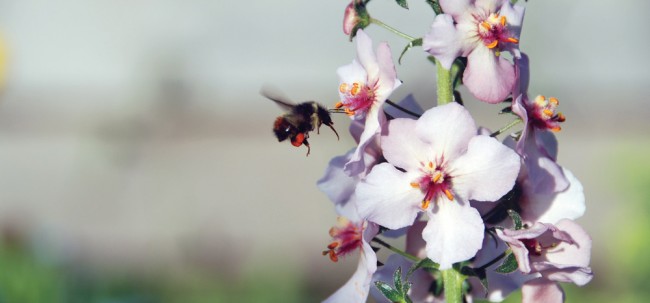
Photo Credit: Emily Bulmer
Native pollinators: The key to garden abundance
Scream! Swoon! Swat! Squish! It’s the recognizable four-step “get that bee out of my hair” jive. The first reaction when many people see insects buzzing around is to smash them against the nearest hard surface.
However, without the important services that these lowly crawlers provide, our gardens would not produce anything we could eat, and the planetary food web would collapse. Pumpkin flowers would wither and drop and apple trees would leaf out, but no shiny globes would appear. Not all insects are “pests,” and by understanding how to recognize and encourage beneficial insects, gardeners can increase their yields and help encourage a healthy ecological community in their gardens.
A symbiotic relationship
Plants can’t move, so they depend on insects to move pollen from one flower to another to assist reproduction. Butterflies, beetles, bees and flies move pollen from the anther, the part of the flower where pollen is produced, to the stigma, the part of the flower where pollen germinates. This pollen transfer is the beginning of the process that turns a tiny, white flower into a juicy, red raspberry.
Insects don’t provide this service for free, however. Ken White, research entomologist with the BC Ministry of Forests, Lands and Natural Resource Operations, describes a mutually beneficial relationship. “Flowers offer insects two things: nectar or pollen. Some insects take advantage of both, and some insects take advantage of one or the other. Bees are the most highly specialized pollinators, and they use both the pollen and the nectar. Some flies have sponge-like mouth parts and can only use the nectar, and some beetle species only use the pollen. These preferences have a big influence on which insects will be attracted to which flowers.”
White explains that according to the fossil record, the number of flowering plant species and the numbers of insect species on earth exploded at the same time. As insects and plants evolved to be more specialized, they formed mutually beneficial relationships that helped each other prosper.
“Moths, butterflies, bees and wasps have specialized mouth parts that can help in getting into certain kinds of flowers. Flower structures and insects have co-evolved—certain mouth parts fit certain flowers. Before these adaptations, pollen was carried by the wind, and fertilization was a chance event,” he says.
While evolution created a diversity of pollinators, with a variety of pollen transport strategies, the industrial food supply chain has become dependent on only a few. Domesticated honeybees have been raised and transported specifically for crop pollination, which has left food production vulnerable when honeybees are struggling.
“Honeybees have had several problems affecting them—Varroa mites, tracheal mites, foulbrood, and colony collapse syndrome,” White says. There are many theories about what is happening, from parasitic flies, pesticide use and nutrient deficiencies. “For all of these reasons, I think it is really important to encourage native pollinators.”
Made for the job
Bumblebees and mason bees are two of the most specialized and efficient native pollinators. Bees feed on flowers—they use nectar as a sugary power food for flying (a bee’s wing flaps 230 times per second!) and collect protein-rich pollen to feed to the larval bees growing in the hive. As they move from one flower to another, bees collect food, and at the same time provide the pollen-moving service that plants need for reproduction. They transport pollen on their hairy bodies as well as on a section of their legs called a pollen basket, which is a flat shiny area surrounded by spiky hairs. The bee presses the pollen onto the basket area and the result is a yellow-orange bulge on its leg—a neatly pressed package of pollen. They can carry up to a quarter of their own weight in pollen. As they fly from flower to flower, some of the previously collected pollen rubs off the bee and falls into the new flower.
“Mason bees and bumblebees have a lower temperature threshold than honeybees,” White notes. “They arrive early in the year and can fly in cooler temperatures than honey bees.” This is an adaptation important for early flowering crops, as well as the cooler environment here in the North.
A little help from their friends
People can encourage native pollinators by providing food and shelter and avoiding the use of pesticides.
“The best thing you can do is plant a wide variety of flowers—different shapes, sizes and colours—as different insects are attracted to different flowers. Providing food throughout the season is also important, which you can support by having flowers that bloom over the whole season,” White says.
In addition to food, bee and insect lovers can provide nesting habitat.
“Wild bumblebees use old mouse holes and rodent burrows for nesting. You can make a bumblebee nest by using an old clay flowerpot with a crack or a chip in the edge – turn it upside down and fill with dog hair or other soft material. Old wooden birdhouses placed on the ground also work well,” says White, who explains that bumblebee colonies are much smaller than honeybee colonies.
“Each hive is about 40 to 50 individual bees. In the spring, a fertilized female that has survived the winter finds a place to make a nest. She lays the eggs, and the new bees that are hatched form the colony and work together to collect food and protect the nest. Mason bees, by contrast, are completely solitary. A single female mason bee collects food, builds the nest and lays the eggs all by herself.”
To encourage mason bees, nesting boxes can be made with plastic straws or ready-made plastic trays, which can be bought from garden supply stores. Neither mason nor bumblebees are aggressive, so you don’t have to worry about attracting stinging insects when you set out homes for them: “The only time I’ve heard of someone getting stung by a bumblebee is when the bee was stepped on,” White says.
Hover flies and beetles are also worth attracting. These insects are not as efficient pollinators compared to bees, but they do provide the additional service of eating aphids, caterpillars and other insects that gardeners consider pests.
“Hover flies are wasp mimics,” White says as he points out a tiny hover fly floating over a flower. “They look like wasps for protection, but they don’t have stingers. Their larvae eat aphids, and they specifically seek out aphid infested plants to lay their eggs.” They can also be identified by their hovering flight pattern, similar to a humming bird.
Soft winged flower beetles eat pollen and their larvae eat other insects. These beetles often have colourful markings on their oblong bodies, and are up to one centimetre in length. Providing mulch materials like leaves or straw gives plenty of places for the beetles to find shelter.
When the raspberries are bowed over with the heaviness of ripe fruit, thank the native pollinators that performed all the heavy lifting. Pay them back by planting some new flowers in a corner of your garden, or give them something homey to burrow in. Remember, without them, everything from apples to zucchinis would disappear. Spend some time getting to know the six-legged miracle workers that toil diligently in your garden and think twice when you have the urge to scream, swoon, swat and squish!







